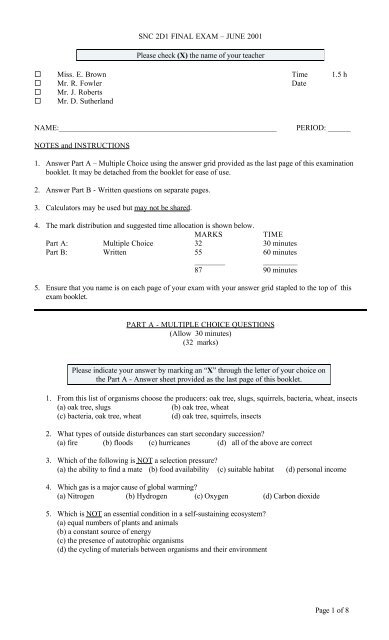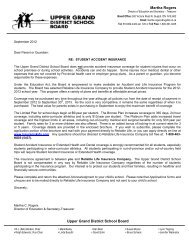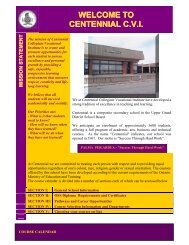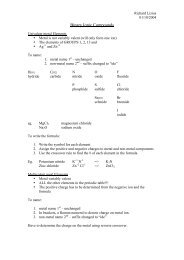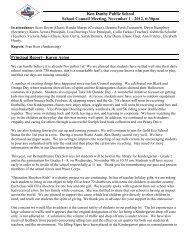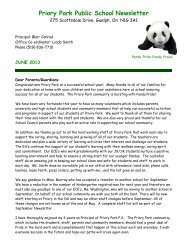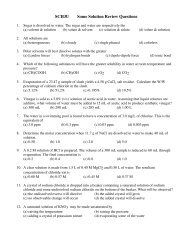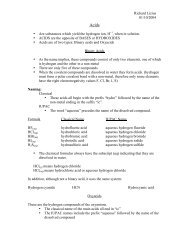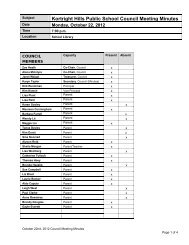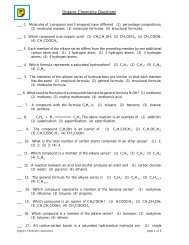Page 1 of 8 SNC 2D1 FINAL EXAM â JUNE 2001 Please check (X ...
Page 1 of 8 SNC 2D1 FINAL EXAM â JUNE 2001 Please check (X ...
Page 1 of 8 SNC 2D1 FINAL EXAM â JUNE 2001 Please check (X ...
Create successful ePaper yourself
Turn your PDF publications into a flip-book with our unique Google optimized e-Paper software.
<strong>SNC</strong> <strong>2D1</strong> <strong>FINAL</strong> <strong>EXAM</strong> – <strong>JUNE</strong> <strong>2001</strong><br />
<strong>Please</strong> <strong>check</strong> (X) the name <strong>of</strong> your teacher<br />
® Miss. E. Brown Time 1.5 h<br />
® Mr. R. Fowler Date<br />
® Mr. J. Roberts<br />
® Mr. D. Sutherland<br />
NAME:_________________________________________________________<br />
PERIOD: ______<br />
NOTES and INSTRUCTIONS<br />
1. Answer Part A – Multiple Choice using the answer grid provided as the last page <strong>of</strong> this examination<br />
booklet. It may be detached from the booklet for ease <strong>of</strong> use.<br />
2. Answer Part B - Written questions on separate pages.<br />
3. Calculators may be used but may not be shared.<br />
4. The mark distribution and suggested time allocation is shown below.<br />
MARKS<br />
TIME<br />
Part A: Multiple Choice 32 30 minutes<br />
Part B: Written 55 60 minutes<br />
________<br />
_________<br />
87 90 minutes<br />
5. Ensure that you name is on each page <strong>of</strong> your exam with your answer grid stapled to the top <strong>of</strong> this<br />
exam booklet.<br />
PART A - MULTIPLE CHOICE QUESTIONS<br />
(Allow 30 minutes)<br />
(32 marks)<br />
<strong>Please</strong> indicate your answer by marking an “X” through the letter <strong>of</strong> your choice on<br />
the Part A - Answer sheet provided as the last page <strong>of</strong> this booklet.<br />
1. From this list <strong>of</strong> organisms choose the producers: oak tree, slugs, squirrels, bacteria, wheat, insects<br />
(a) oak tree, slugs<br />
(b) oak tree, wheat<br />
(c) bacteria, oak tree, wheat (d) oak tree, squirrels, insects<br />
2. What types <strong>of</strong> outside disturbances can start secondary succession?<br />
(a) fire (b) floods (c) hurricanes (d) all <strong>of</strong> the above are correct<br />
3. Which <strong>of</strong> the following is NOT a selection pressure?<br />
(a) the ability to find a mate (b) food availability (c) suitable habitat (d) personal income<br />
4. Which gas is a major cause <strong>of</strong> global warming?<br />
(a) Nitrogen (b) Hydrogen (c) Oxygen (d) Carbon dioxide<br />
5. Which is NOT an essential condition in a self-sustaining ecosystem?<br />
(a) equal numbers <strong>of</strong> plants and animals<br />
(b) a constant source <strong>of</strong> energy<br />
(c) the presence <strong>of</strong> autotrophic organisms<br />
(d) the cycling <strong>of</strong> materials between organisms and their environment<br />
<strong>Page</strong> 1 <strong>of</strong> 8
6. A homeowner left the grass clippings on the lawn when it was mowed. She discovered that the lawn<br />
needed less fertilizer than it did when she collected the clippings. This is because<br />
(a) energy flow is one way<br />
(b) energy must enter the lawn ecosystem from the sun<br />
(c) the clippings help retain water<br />
(d) nutrients are recycled<br />
7. Organisms that convert complex compounds into simpler compounds that are than returned to the<br />
environment for use by other organisms are best classified as<br />
(a) consumers (b) producers (c) decomposers (d) autotrophs<br />
8. The element that is the basis <strong>of</strong> life on this planet, and is recycled by the processes <strong>of</strong><br />
photosynthesis and respiration is<br />
(a) silicon (b) sulfur (c) nitrogen (d) carbon<br />
9. What abiotic factor might be an important part <strong>of</strong> a grassy field environment?<br />
(a) daily and seasonal temperature changes<br />
(b) the microorganism population<br />
(c) species competition<br />
(d) the number <strong>of</strong> food chains<br />
10. Which process removes nitrogen from the air?<br />
(a) Nitrogen fixation (b) Denitrification (c) Photosynthesis (d) Eutrophication<br />
11. In which atmospheric layer does most weather occur?<br />
(a) stratosphere (b) mesosphere (c) troposphere (d) thermosphere (e) magnetosphere<br />
12. Between 60 o latitude and the poles, surface winds tend to flow:<br />
(a) north to south (b) east to west (c) south to north (d) west to east<br />
13. In Canada, jet streams are high-speed winds in the upper troposphere that move:<br />
(a) north to south (b) east to west (c) south to north (d) west to east<br />
14. During El Niño:<br />
(a) the trade winds travel eastward, and rainfall increases along the coast <strong>of</strong> Peru.<br />
(b) the trade winds travel westward, and rainfall increases along the coast <strong>of</strong> Peru.<br />
(c) the surface temperatures <strong>of</strong> the Pacific Ocean decreases, eases along the coast <strong>of</strong> Peru.<br />
(d) the trade winds travel eastward, and rainfall decreases along the coast <strong>of</strong> Peru.<br />
15. Ocean currents are NOT<br />
(a) always the same temperature as the surrounding water.<br />
(b) affected by the shapes <strong>of</strong> the continents.<br />
(c) started by the wind.<br />
(d) influenced by the Coriolis effect.<br />
(e) one <strong>of</strong> the ways that heat is transferred from the tropics to the poles.<br />
16. An exothermic reaction is one where:<br />
(a) a high temperature is needed to run the reaction.<br />
(b) heat energy does not need to be applied to start the reaction.<br />
(c) heat energy is not a factor.<br />
(d) heat energy is used up.<br />
(e) heat energy is given <strong>of</strong>f.<br />
17. What type <strong>of</strong> reaction does the following equation represent?<br />
Ag 2 S Æ 2Ag + S<br />
(a) single displacement (b) synthesis (c) combustion<br />
(d) double displacement<br />
(e) decomposition<br />
18. A solution has a pH <strong>of</strong> 8. How is this solution best described?<br />
(a) strongly basic (b) slightly basic (c) slightly acidic<br />
(d) strongly acidic<br />
(e) neutral<br />
<strong>Page</strong> 2 <strong>of</strong> 8
19. According to the "collision model,” the rate <strong>of</strong> a chemical reaction could be increased by which <strong>of</strong> the<br />
following?<br />
1. carrying out the reaction at a higher temperature<br />
2. adding a catalyst<br />
3. increasing the surface area <strong>of</strong> solid reactants<br />
4. increasing the concentration <strong>of</strong> reactants<br />
(a) 1, 2, and 3 only (b) 1, 3, and 4 only (c) 1, 2, and 4 only<br />
(d) 2, 3, and 4 only (e) 1, 2, 3, and 4<br />
20. Select the balanced equation.<br />
(a) 4 K + 4 H2O Æ 4 KOH + H2<br />
(b) 3 Mg(OH)2 + 2 H3PO4 Æ Mg3(PO4)2 + 4 H2O<br />
(c) FeS + 2 HCl Æ H2S + FeCl2<br />
(d) 2 Fe + 4 HCl Æ 2 FeCl3 + 2 H2<br />
(e) 2 ZnS + 2 O2 Æ 2 ZnO + 2 SO2<br />
21. Which <strong>of</strong> the following is a vector quantity?<br />
(a) displacement (b) speed (c) time (d) distance<br />
22. The direction [S 20 o E] is the same as<br />
(a) 70 o RCS (b) 20 o RCS (c) 290 o RCS (d) 310 o RCS<br />
23. Average speed can best be defined as<br />
(a) the speed at which an object is travelling at a particular instant;<br />
(b) an object travelling at the same speed over a period <strong>of</strong> time;<br />
(c) the total distance covered over the total time measured;<br />
(d) the rate <strong>of</strong> change in speed.<br />
24. Instantaneous speed and average speed are always the same when<br />
(a) the time period they are measured in is very great.<br />
(b) the distance traveled by the object undergoing instantaneous and average speed is the same.<br />
(c) the speed is uniform or constant.<br />
(d) the acceleration is changing per unit time.<br />
25. Acceleration is defined as<br />
(a) change in position over a period <strong>of</strong> time<br />
(b) change in velocity over a period <strong>of</strong> time;<br />
(c) same position over a period <strong>of</strong> time<br />
(d) the time it takes for an object to go from position 1 to position 2.<br />
26. An object covering less and less distance per unit time is an example <strong>of</strong><br />
(a) constant speed (b) speeding up (c) instantaneous speed (d) slowing down<br />
27. Sabrina competes in marathon races. If the length <strong>of</strong> the races remains the same and her times<br />
decrease, what is happening to her average speed?<br />
(a) Her average speed remains the same.<br />
(b) Her average speed decreases.<br />
(c) Her average speed increases.<br />
(d) You cannot tell from the data given.<br />
28. An object is thrown vertically upward. At the top <strong>of</strong> its trajectory<br />
(a) its velocity is zero and its acceleration is zero<br />
(b) its velocity is zero and its acceleration is 9.8 m/s 2 down<br />
(c) its velocity is zero and its acceleration is 9.8 m/s 2 up<br />
(d) its velocity is 9.8 m/s down and its acceleration is zero<br />
(e) its velocity is 9.8 m/s up and its acceleration is zero<br />
<strong>Page</strong> 3 <strong>of</strong> 8
29. Examine the position-time graph below.<br />
The motion that is shown on this graph can best be described as<br />
(a) uniformly decreasing positive velocity (b) constant negative velocity<br />
(c) constant negative acceleration<br />
(d) uniformly decreasing negative velocity<br />
30. A blue jay flies at 10 km/h for 320 km [N]. How long would this journey take it?<br />
(a) 32 h (b) 3200 h (c) 0.031 h (d) 3200 h [N]<br />
31. A person kicks a soccer ball from rest to a velocity <strong>of</strong> 20 m/s [towards the goal] in 0.5 s. The<br />
acceleration <strong>of</strong> the ball is:<br />
(a) 20 m/s 2 [away from the goal]<br />
(b) 0.025 m/s 2 [towards the goal]<br />
(c) 40 m/s 2 [towards the goal]<br />
(d) 10 m/s 2 [away from the goal]<br />
32. If a car starts from rest and accelerates at +2.5 m/s 2 for 5.0 s, it will have a final velocity <strong>of</strong><br />
(a) 0.5 m/s (b) 7.5 m/s (c) 12.5 m/s (d) 2.0 m/s<br />
PART B - WRITTEN RESPONSE<br />
(Allow 60 minutes)<br />
(55 marks)<br />
33. Yeast are single celled fungi that use sugar as a food supply. When deprived <strong>of</strong> oxygen, they convert<br />
sugar to carbon dioxide gas and alcohol. This reaction releases energy, and the yeast use that energy<br />
to grow and reproduce rapidly. Alcohol is toxic to the bacteria.<br />
An experiment was conducted over a period <strong>of</strong> nine days. The purpose <strong>of</strong> the experiment was to<br />
examine the growth pattern <strong>of</strong> yeast. The experimenters placed a sample <strong>of</strong> yeast in a sterilized<br />
molasses and water mixture and counted the population each day. The graph below summarizes the<br />
results <strong>of</strong> their experiment.<br />
Population<br />
(cells/mL)<br />
80<br />
70<br />
60<br />
50<br />
40<br />
30<br />
20<br />
10<br />
0<br />
1 2 3 4 5 6 7 8 9<br />
Days<br />
(a) Explain and give reasons for the population pattern from days 1 through 6. [1 mark]<br />
(b) Explain what might have caused the change in the growth pattern from day 7 through 9. [1 mark]<br />
<strong>Page</strong> 4 <strong>of</strong> 8
34. List 2 benefits and 2 costs that the use <strong>of</strong> biotechnology for food production may have for society<br />
and the environment? [2 marks]<br />
35. Rabbits are not indigenous to Australia. They were brought to Australia as a meat source for the<br />
European settlers. At some point some <strong>of</strong> the rabbits managed to escape into the wild where there<br />
were no natural predators. Note that the Dingo, a type <strong>of</strong> wild dog which is indigenous to Australia<br />
is not native to the area in which the rabbit was introduced. Sheep rearing was and still is a major<br />
activity throughout much <strong>of</strong> rural Australia.<br />
(a) Give the sheep containing food chain which the Australian settlers desired. [1 mark]<br />
(b) Describe the direct effect that the introduction <strong>of</strong> the rabbit would have upon the desired food<br />
chain? [1 mark]<br />
(c) Describe any additional effects would this have on the ecosystem and the economy over a period<br />
<strong>of</strong> time? [1 mark]<br />
(d) Propose a possible method <strong>of</strong> solving the rabbit problem in Australia? Discuss how this would<br />
work and its possible ecological consequence.[2 mark]<br />
36. When carbon dioxide gas is dissolved in water, some <strong>of</strong> the gas reacts to form carbonic acid.<br />
Bromothymol blue indicator turns yellow in the presence <strong>of</strong> acids. The figure below describes an<br />
experiment in which bromothymol blue indicator was added to each <strong>of</strong> four test tubes.<br />
All <strong>of</strong> the test tubes were stored near a window and at the same temperature. The test tubes were<br />
observed at the beginning <strong>of</strong> the experiment and after two weeks. Observations from the experiment<br />
are recorded in the Table below.<br />
Test Tube Initial colour <strong>of</strong> the water plus<br />
indicator<br />
1 dark blue dark blue<br />
2 dark blue dark blue<br />
3 dark blue yellow<br />
4 dark blue light blue<br />
(a) Explain why test tube 3 changed colour, but test tube 2 did not. [2 marks]<br />
(b) Explain why is there little change in colour in test tube 4? [1 mark]<br />
Final colour <strong>of</strong> water plus<br />
indicator<br />
37. Explain why clouds form if the air temperature drops quickly like it does during a solar eclipse.<br />
[1 mark]<br />
38. Northern towns such as Moosenee on the shore <strong>of</strong> James Bay are not appreciably farther away from<br />
the sun than cities close to the equator such as Mexico City and yet the average temperature in<br />
Moosenee is much lower than that <strong>of</strong> Mexico City. Explain. [2 marks]<br />
39. Explain how the specific heat capacity <strong>of</strong> water allows it to influence weather. [2 marks]<br />
40. Explain the interaction <strong>of</strong> convection currents and the eastward rotation <strong>of</strong> Earth in producing the<br />
northeast trade winds in the Tropic <strong>of</strong> Cancer. [3 marks]<br />
<strong>Page</strong> 5 <strong>of</strong> 8
41. With the aid <strong>of</strong> diagrams, explain the role <strong>of</strong> convection currents in the three stages <strong>of</strong> a<br />
thunderstorm. [3 marks]<br />
42. Give the compound name or formula as required. [6 marks]<br />
(a) K 2 S<br />
(b) sodium oxide<br />
(c) iron(II) bromide<br />
(d) SO 2<br />
(e) silicon tetrabromide<br />
(f) dichlorine monoxide<br />
43. A shiny, substance (X), which can be shaped and which is an excellent conductor <strong>of</strong> electricity, is<br />
burned in air to produce a white solid (Y). When this solid is placed in water, it slowly dissolves to<br />
form a colourless solution (Z).<br />
(a) What kind <strong>of</strong> substance is X? Explain. [2 marks]<br />
(b) What kind <strong>of</strong> substance (bonding) is Y? Explain [2 marks]<br />
(c) What kind <strong>of</strong> solution is Z? Explain. [2 marks]<br />
44. The antacid preparation Maalox contains aluminum hydroxide (Al(OH) 3 ) and magnesium hydroxide<br />
(Mg(OH) 2 ).<br />
(a) What kind <strong>of</strong> compounds are aluminum hydroxide and magnesium hydroxide? [1 mark]<br />
(b) Explain how Maalox decreases the excess hydrochloric acid in an upset stomach. [1 mark]<br />
(c) Write balanced chemical equations which illustrate the reaction between each active ingredient in<br />
Maalox that reacts with the excess stomach acid (HCl) [3 marks].<br />
(d) You want to design a new antacid tablet that is as small as possible, yet is as effective at<br />
neutralizing stomach acid as larger ones. Considering the chemical equations in (c) above, which <strong>of</strong><br />
these substances would you choose to be in your new tablet? Explain your choice. [2 marks]<br />
45. A dog leaves home and runs 30 m [E], then turns and runs 60 m [N 30 o W]. By means <strong>of</strong> a scale<br />
diagram, determine the dog’s final displacement. [3 mark]<br />
46. Consider the following position versus time graph.<br />
position (m [W] <strong>of</strong> home)<br />
40<br />
30<br />
20<br />
10<br />
0<br />
-10<br />
5 10 15 20 25 30 35<br />
time<br />
(s)<br />
-20<br />
Using the above graph, determine each <strong>of</strong> the following. Where a mathematical solution is required,<br />
show your work.<br />
(a) the average velocity during the first 10 s. [2 marks]<br />
(b) the displacement during the first 20 s. [1 mark]<br />
<strong>Page</strong> 6 <strong>of</strong> 8
47. Consider the following velocity versus time graph.<br />
velocity (m/s [N])<br />
15<br />
10<br />
5<br />
0<br />
-5<br />
2 4 6 8 10 12 14<br />
time<br />
(s)<br />
-10<br />
Using the above graph, determine each <strong>of</strong> the following. Where a mathematical solution is required,<br />
show your work.<br />
(a) the instantaneous velocity at t = 3.0 s. [1 mark]<br />
(b) the acceleration at t = 6.0 s. [2 marks]<br />
48. A car, initially traveling at 20 m/s [N] accelerates uniformly at 1.6 m/s 2 [N]. Determine<br />
(a) its velocity after 4.0 s. [2 marks]<br />
(b) the distance traveled by the car during the 4.0 s time interval. [2 marks]<br />
<strong>Page</strong> 7 <strong>of</strong> 8
<strong>SNC</strong> <strong>2D1</strong> <strong>FINAL</strong> MARK SHEET – <strong>JUNE</strong> <strong>2001</strong><br />
Remove this sheet form the examination booklet for ease <strong>of</strong> use.<br />
<strong>Please</strong> <strong>check</strong> (X) the name <strong>of</strong> your teacher<br />
® Miss. E. Brown Time 1.5 h<br />
® Mr. R. Fowler Date<br />
® Mr. J. Roberts Place<br />
® Mr. D. Sutherland<br />
NAME:_________________________________________________________<br />
PERIOD: ______<br />
PART A – MULTIPLE CHICE ANSWER GRID<br />
<strong>Please</strong> indicate your answer by marking an “X” through the letter <strong>of</strong> your choice.<br />
1. a b c d e 21. a b c d e<br />
2. a b c d e 22. a b c d e<br />
3. a b c d e 23. a b c d e<br />
4. a b c d e 24. a b c d e<br />
5. a b c d e 25. a b c d e<br />
6. a b c d e 26. a b c d e<br />
7. a b c d e 27. a b c d e<br />
8. a b c d e 28. a b c d e<br />
9. a b c d e 29. a b c d e<br />
10. a b c d e 30. a b c d e<br />
11. a b c d e 31. a b c d e<br />
12. a b c d e 32. a b c d e<br />
13. a b c d e<br />
14. a b c d e<br />
15. a b c d e<br />
16. a b c d e<br />
17. a b c d e<br />
18. a b c d e<br />
19. a b c d e<br />
20. a b c d e<br />
<strong>Page</strong> 8 <strong>of</strong> 8


